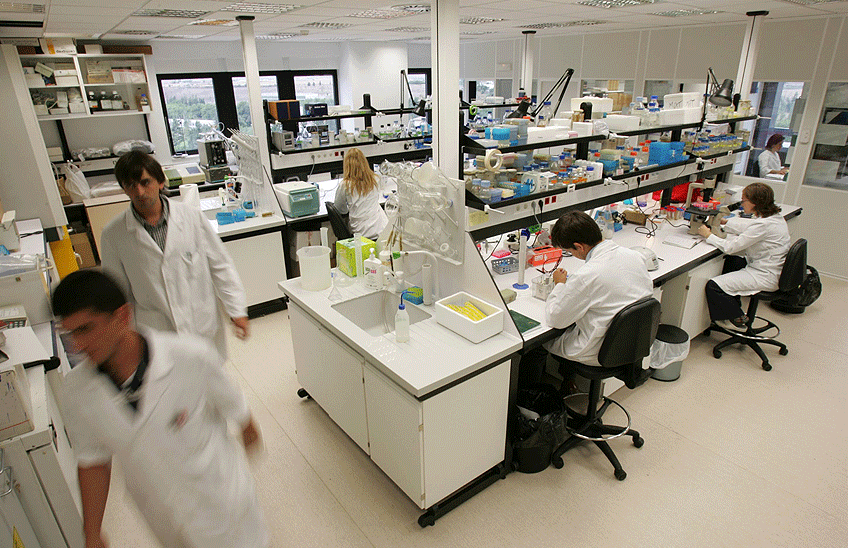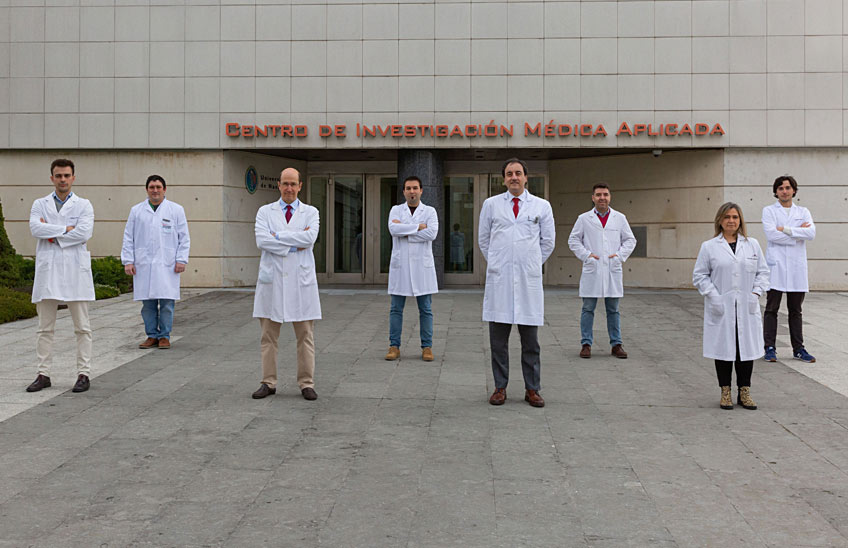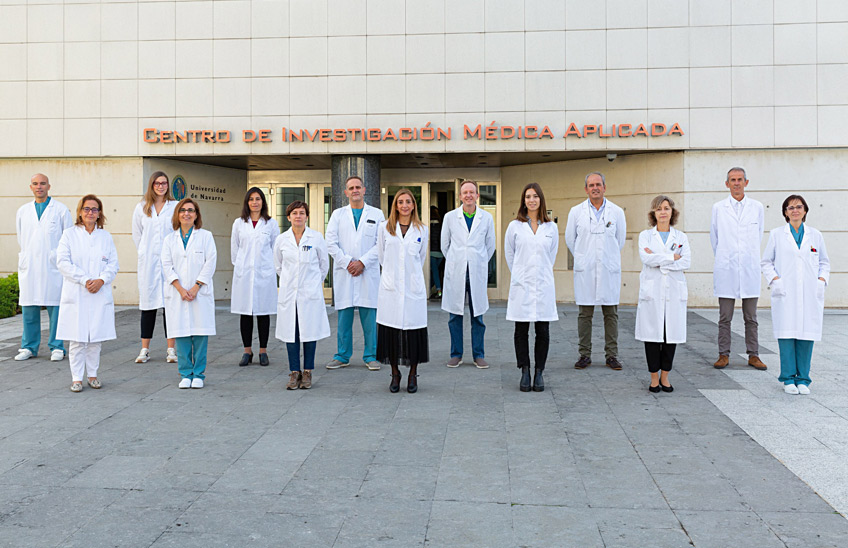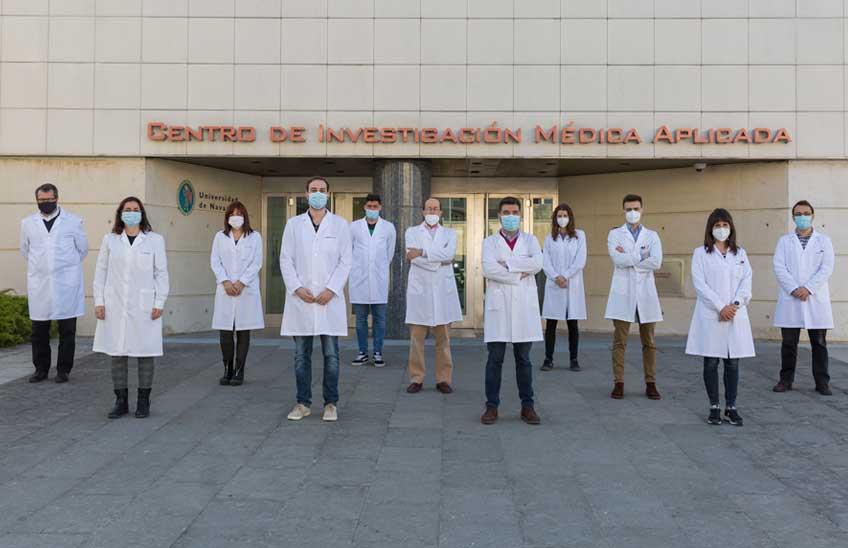Spanish researchers develop a strategy to more effectively diagnose pancreatic and bile duct tumours
This novel study carried out at the Cima University of Navarra and the Navarra Hospital Complex detects mutations in the DNA present in the bile of cancer patients.
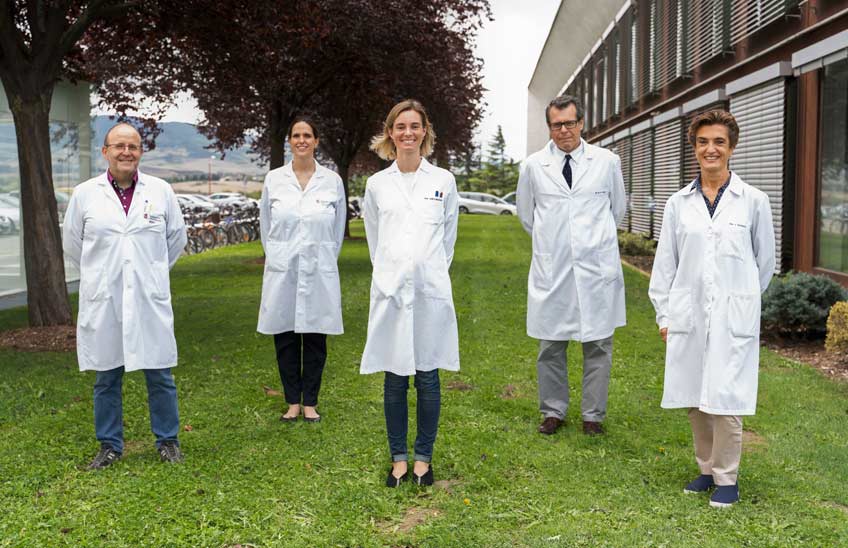
PhotoManuelCastells/Dr Jesús Urman, María Rullán, María Arechederra, Matías Ávila and Carmen Berasain, researchers at Cima University of Navarra and the Navarra Hospital Complex.
22 | 09 | 2021
Approximately 3,000 new patients are diagnosed each year in Spain with cholangiocarcinoma, the most common bile duct tumour, and 8,700 with adenocarcinoma of the pancreas. These tumours are often detected in advanced stages, which makes surgical treatment difficult. Therefore, an early approach is essential to improve the prognosis of these patients.
Spanish researchers have developed a new strategy that makes it possible to diagnose these types of tumours with very high efficacy. It is an approach based on the analysis by massive sequencing of the DNA present in bile. The results have been published in the prestigious journal Gut.
Endoscopic retrograde cholangiopancreatography (ERCP) is a common examination in the management of stricture (narrowing) of the bile duct, a lesion that may be caused by the presence of tumours. This test is useful for radiological imaging, sampling the tumour and draining the stricture. However, its sensitivity for detecting malignant lesions is around 50%. Therefore, the absence of a diagnosis means that invasive tests have to be repeated and can sometimes lead to unnecessary surgical resections, which puts the patient at risk, increases healthcare costs and delays the oncological diagnosis.
"Our BileMUT study analyses bile collected during ERCP, so it poses no additional risk to patients. Bile fluid is at contact directly with the cells of the bile duct system, including pre-malignant and malignant cells, if present. In this work we have evaluated the presence of DNA mutations isolated from the bile of patients who received an initial benign or indeterminate diagnosis and we have identified 100% of the cases that subsequently developed cancer," explain Drs Matías Ávila and Carmen Berasain, researchers from the Hepatology Programme at Cima and the CIBER de Enfermedades Hepáticas y Digestivas (CIBEREHD), and Dr Jesús Urman, a specialist at the Complejo Hospitalario de Navarra, coordinators of the study.
Next generation sequencing
The procedure analysis was performed using next-generation sequencing (NGS) techniques. "To accelerate the application of this study in the clinical internship we chose a commercial liquid biopsy panel open to implementation in clinical laboratories. Therefore, this essay is available and can be routinely performed in hospitals equipped with conventional NGS technologies", explain Drs. Gorka Alkorta and María Arechederra, researchers at CIMALAB Diagnostics and the Hepatology Programme of the CimaHepatology Programme, respectively.
The results indicate that this study can advance the diagnosis and treatment of patients with biliary stricture and suspected pancreatic or bile duct cancer. "BileMUT can change the diagnostic landscape in an area that is still far from being satisfactorily resolved. In addition, it can also help select patients to be treated with new personalised drugs. Its application can avoid the repetition of diagnostic procedures, decreasing the risk of complications, as well as additional medical expenses," say Dr. Jesús Urman and Dr. María Rullán, Digestive System specialists at the Complejo Hospitalario de Navarra and Hospital García Orcoyen, respectively.
This work has been carried out with patient samples from the Navarrabiomed Biobank, at the framework of the high school of research Sanitaria de Navarra (IdiSNA) and the Euroregion New Aquitaine-Euskadi-Navarre. The project BileMUT is funded by the Government of Navarra (through the project AGATA and the department de Salud) and the association Española contra el Cáncer (AECC), among other public and private institutions.
reference letter bibliographic
-
Next-generation sequencing of bile cell-free DNA for the early detection of patients with malignant biliary strictures
-
Gut. 2021 Jul 20;gutjnl-2021-325178. doi: 10.1136/gutjnl-2021-325178.

